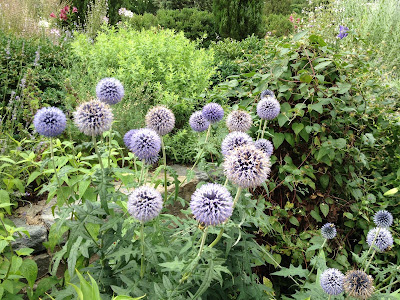Today, Sunday, we got up feeling a need for at least a brush with culture. The National Cathedral fit the bill nicely, and was not too far away, so we drove to the church and took advantage of free underground parking on Sundays as well as two very special events scheduled for the afternoon.
Started in 1907 with a speech from President Theodore Roosevelt, and not finished until 83 years later with a speech from President George H.W. Bush, it is an impressive structure built in the English Gothic style. Built stone upon stone, with concrete and steel at strategic points (the steel replaces the wooden beams that were used in European Cathedrals for roof support beams), it is the second largest cathedral in the country and the sixth largest in the world as well as the fourth tallest building in Washington, D.C.
We joined a tour in progress in the nave.
The cathedral is the seat of the Presiding Bishop of the Episcopal Church, and had an average attendance at Sunday services in 2009 of 1,667. It does not receive any financial support from the federal government and so relies on donations.
The final design of the cathedral shows a mix of influences from the various Gothic architectural styles of the Middle Ages, with its pointed arches, flying buttresses, ceiling vaulting, stained-glass windows and carved stone. The tallest of its three towers rises 301 feet above the ground and the church is built on the highest point of land in Washington. Most of the building is built of Indiana limestone, the pulpit was carved from stones from Canterbury Cathedral, and the high altar, The Jerusalem Alter is made from stones quarried at Solomon's Quarry near Jerusalem, reputedly where the stones for Solomon's Temple were quarried. There are 214 stained glass windows, shining on monumental cast bronze gates, forged iron and intricate wood carving.
One very interesting architectural detail are the intentional flaws introduced in keeping with a medieval custom that sought to illustrate that only God can be perfect. These flaws, which come in the form of intentional asymmetries, compensate for visual distortions that occur in large spaces, a practice that has been used since the Pyramids and the Parthenon. In this case, the main aisle of the cathedral where it meets the cross section is tilted slightly off its axis, reducing the foreshortening that would occur from perspective.
The main altar shows Jesus and the Disciples. Note that the carving of Jesus, in the center, is a slightly different color. That carving needed to be redone, but the limestone used originally was no longer available, and the blocks that had been set aside for future use had deteriorated. A search was conducted for a color matched stone and this was the closest that could be found. It is said that the Disciples are from Indiana, but Christ is from Texas...
One bank of the 10,000 plus pipe organ:
Outside, the flying buttresses are easily seen from the Bishops Garden.
The scaffolding is part of the reconstruction project necessary after the 2011 earthquake that damaged the cathedral extensively on the exterior. Many of the gargoyles and decorative carvings were damaged.
A soothing walk through the Bishops Garden gave us a quiet break from the structure.
The garden is beautiful, with hundreds of well kept plants. Some flowers have visitors.
There are nine chapels in the cathedral, including this small, ornate chapel for children. The ceiling is carved with designs from Noah's Ark, and the furniture is proportionately sized for children.
Our camera wouldn't do justice to the stained glass windows, but we managed to get a few pics.
The scale of even the areas on the sides of the nave are incredible!
From the seventh floor observation floor, looking southeast, we can see the vice-presidents house center left with the grey roof, located on the Naval Observatory Grounds, and the Washington Monument and the Jefferson Memorial in the distance to the left of the Potomac River.
Our interest was piqued by mention of evening events that included the Sunday Choral Evensong at 4:00 pm. The guest choir was the Ottowa Cathedral Mens and Boys Choir, and what a performance it was! I have no idea of the protocol for standing, sitting, and repeating phrases, but the pageantry and choral numbers were extraordinary!
An hour later, just after five, Ms Chuyoung Suter of Gaithersburg, Maryland, gave an Organ Recital. Never having experienced this, we joined the crowd in the choir pews for three impressive numbers, including "Variations sur un vieux Noel en re miner, Op. 20", "Prelude, fugue et variation, Op. 18", and "Sonate fur die Orgel "Der 94ste Psalm"". Now, that's culture!
Ms Suter has impressive credentials and is Coordinator of Piano Study for choristers at Washington National Cathedral, as well as Organist at Good Sheperd Lutheran Church in Gaithersburg, Maryland. She provided us with a view into the specialized world of those who command these huge pipe organs.
On our way back to Cherry Hill Park, we noticed a number of very nice old houses on tree lined streets in Chevy Chase, Maryland, and Bethesda, Maryland, as we went through. A very affluent and beautiful area, indeed.
The cathedral is very impressive, and the performances interesting. But enough of the culture thing…..Now it's back to the tourist life for us!
















No comments:
Post a Comment